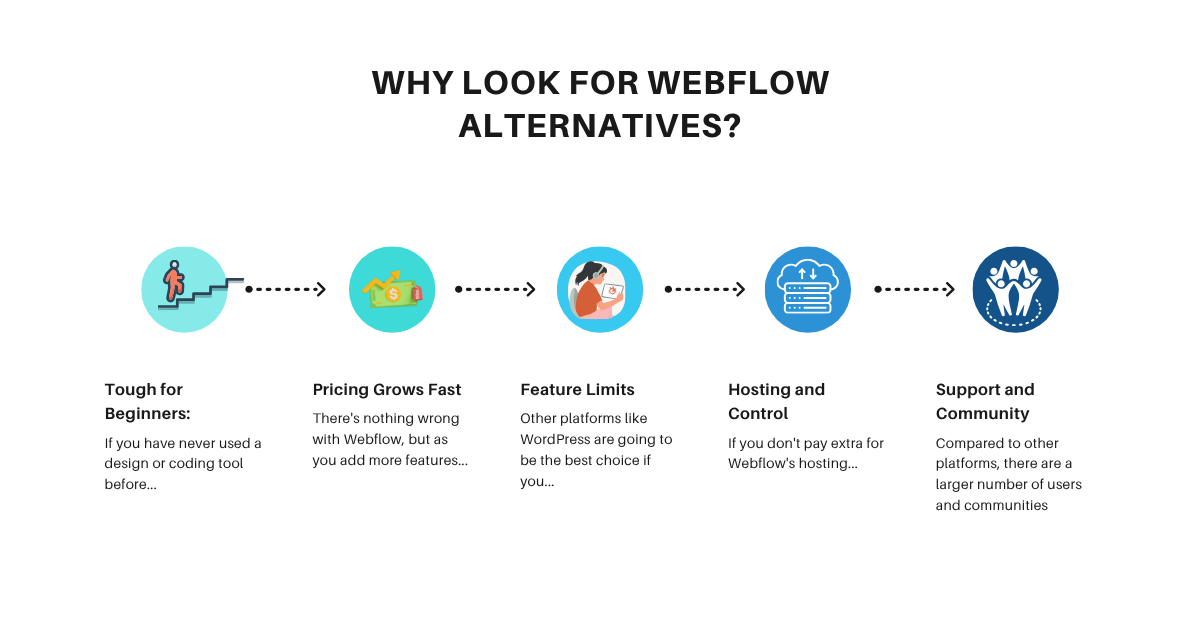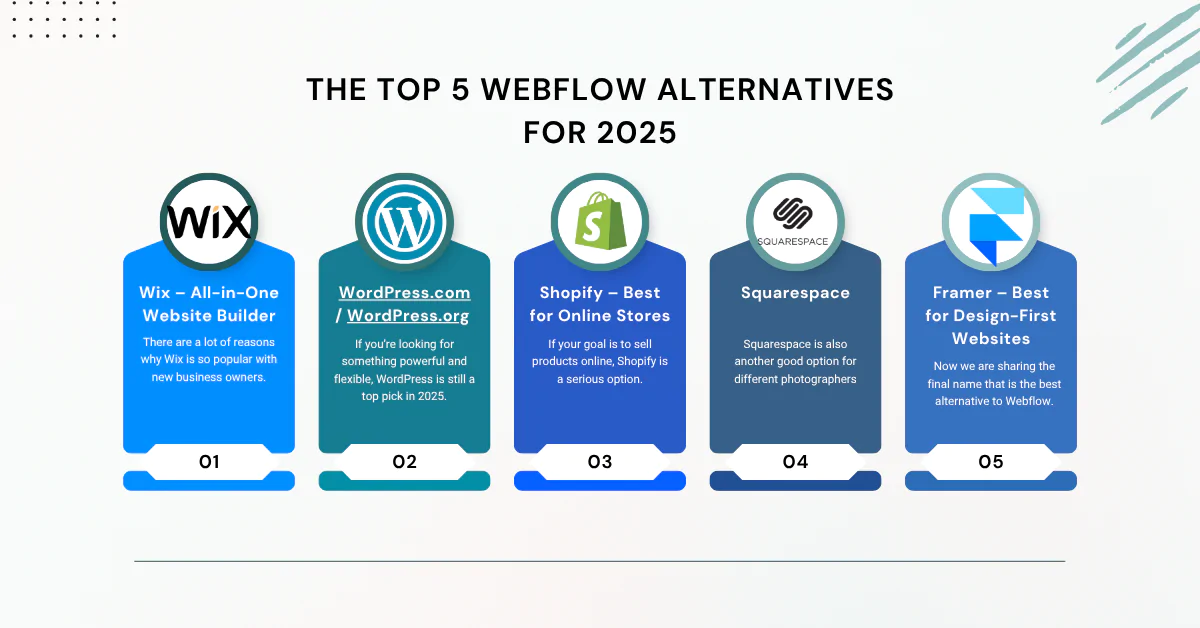Webflow website builder has been one of the best options available to people who want to build websites without the need to write any code. In 2025, however, things are going to be very different. We are going to see a lot more tools coming out shortly. You will find some of them are easier to use, some are more affordable, and some are more flexible than others. I can assure you that you are not alone in your search for the best Webflow alternatives if you find yourself here.
Maybe Webflow is expensive for you. Or maybe it’s just not giving you what you need anymore, especially for e-commerce or fast-growing websites. Whatever the reason, there are other builders and platforms out there that do the job just as well, or in some cases, even better.
In this guide, we’ve made it simple for you. Here are the top 5 Webflow alternatives worth checking out in 2025. Each with its own pros, use cases, and who it’s really for.
Quick Comparison Table
| Platform | Best For | Strengths | E-Commerce | Price Start |
| Wix | Beginners, small businesses | Easy drag-and-drop, all-in-one | Yes | ₹250/per month |
| WordPress | Blogs, versatile sites | Highly customizable | Yes (via WooCommerce) | Free |
| Shopify | Online stores | Built for selling products | Yes | ₹1,499/per month |
| Squarespace | Design-focused websites | Beautiful templates, easy to use | Yes | $16 per month |
| Framer | Modern teams and agencies | Fast, collaborative, no-code | Limited | Free/₹2,700/month |
Why Look for Webflow Alternatives?

It is no secret that Webflow is one of the most popular and powerful website builders available today, especially among designers. There is, however, a downside to it. Some of the common reasons why people look for other options are as follows:
1. Tough for Beginners:
If you have never used a design or coding tool before, then Webflow may seem difficult to you. If you like a simple drag-and-drop environment where you can move things around easily, there are other builders you can use.
2. Pricing Grows Fast:
There’s nothing wrong with Webflow, but as you add more features or get more visitors, you’ll have to pay more. If you have a small business or are on a tight budget, for example, other website-building options might be a good option.
3. Feature Limits:
Other platforms, like WordPress, are going to be the best choice if you want to develop a blog-style website. As Webflow does not cover all needs equally well, people sometimes turn to platforms that specialize in those specific features in order to meet their needs.
4. Hosting and Control:
If you don’t pay extra for Webflow’s hosting, you will be tied to their server. A lot of people prefer to be able to control where and how their website is hosted.
5. Support and Community:
Compared to other platforms, there are a larger number of users and communities. Additionally, there is more help, including plugins, tools, and developers, on hand to assist if needed.
The Top 5 Webflow Alternatives for 2025

Here are the five best Webflow alternatives, each with its own strengths. I’ll share the best options below so you can decide according to your needs.
1. Wix – All-in-One Website Builder
There are a lot of reasons why Wix is so popular with new business owners. When it comes to easy-to-use website building tools, Wix is the best. With Wix, you do not have to write a single line of code in order to create your website. Until today in 2025, Wix has so many beautiful themes and easy to use drag options.
A. Why Wix is a great choice:
- You can click and drag everything where you want.
- Hundreds of themes for all types of business or personal websites.
- Built-in tools for online stores, blogs, bookings, and more.
- Helps you build your website SEO-friendly and search engine-optimized.
- Great for small to medium-sized businesses, freelancers, creatives, and anyone who wants a website in no time.
B. When to use Wix:
In case you want to get a site up quickly and easily, without having to get technical or worry about the process, then Wix is the right choice for you.
C. Pricing:
- Light: ₹250/per month
- Core: ₹500/per month
- Business: ₹900/per month
- Business Elite: ₹1800/per month
2. WordPress.com / WordPress.org – The Most Flexible Option
If you’re looking for something powerful and flexible, WordPress is still a top pick in 2025. WordPress powers over 43% of all websites on the Internet.
WordPress is an open-source platform, which means you have full control. With WordPress, you can build almost any type of website, from blogs to business sites to eCommerce stores. WordPress offers thousands of themes and plugins.
And with plugins like Elementor or Divi, you can simply drag an element and drop it wherever you want it to show. It’s as simple as that. If you’re working with a WordPress development services team, they can help with custom features, integrations, and even faster load speeds using WordPress speed optimization services.
A. Why people like WordPress:
- You can make all types of sites—blog, business, online shop, portfolio, even a full news site.
- There are thousands of themes and plugins. And if you want to build a custom feature, you can also do that with the help of a web development company.
- If you use WordPress.org (the self-hosted one), you get full control. You handle speed, security, and updates your way.
- If you don’t want to do it alone, many people offer WordPress setup and development services—you can get help easily.
- It’s also good for SEO. So if you want your website to show on Google, WordPress makes that part easier.
B. When to pick WordPress:
If you want something that can grow slowly with your work, or if you’re planning to post blogs, news, or regular updates, WordPress is the one you can trust.
C. Pricing:
WordPress software is free. Hosting can be found starting as low as $5 per month.
3. Shopify – Best for Online Stores
If your goal is to sell products online, Shopify is a serious option. Webflow does support eCommerce, but Shopify was built for it. Shopify is simple to use, fast, and supports everything from inventory tracking to payments. Whether you’re just starting out or running a big store, it grows with you. With apps, themes, and powerful support, it’s perfect for sellers who want results.
If you want a custom design and faster performance, a Shopify development company can help build your store from scratch. There’s also Shopify theme customization available if you want to give your store a unique look. And if you’re scaling up, a Shopify plus design agency is your go-to.
A. Why Shopify:
- You can set up your store quickly. It takes care of everything—product listings, payments, and checkout.
- You get tools to manage stock, orders, shipping, and talking to customers—all in one place.
- It works whether you sell just one item or thousands. You can grow slowly or fast—Shopify can handle it.
- If you need help, there are plenty of Shopify experts and companies who can build or fix things for you.
- Good choice if you’re serious about running a proper online business.
B. When Shopify is best:
If selling products online is your main goal, Shopify is the only platform that offers a lot of the features you’ll need every day.
C. Pricing:
- Basic: ₹1,499 INR /month
- Grow: ₹5,599 INR /month
- Advanced: ₹22,680 INR /month
- Plus: ₹175,000 INR /month
4. Squarespace – Best for Creatives and Visual Brands
Squarespace is also another good option for different photographers, artists, and personal brands out there. The design templates are polished and clean, and require no setup at all. With Squarespace, you will get hosting, a domain, templates, analytics, and even email marketing tools in one dashboard. Yes, that’s right! And this thing, for example, makes it a perfect Webflow alternative for people who don’t want to manage 10 different services.
That said, it’s not as flexible as WordPress or Shopify. But if your goal is to launch a modern, beautiful website without too many technical choices, Squarespace is a perfect option then.
A. Why Squarespace is the best option:
- It gives you beautiful templates that look good on both phone and computer.
- You can change colours, fonts, and layout without needing any coding or extra plugins.
- Blogging and online store options are already there; you don’t have to add anything extra.
- You can also connect your email, social media, and basic marketing—all from one place.
- It’s a good choice for designers, artists, coaches, or small business owners.
B. When to choose Squarespace:
If design and ease of use are something you need at any cost, Squarespace is the best platform for you in that case.
C. Pricing:
- Personal: $16 /month
- Business: $23 /month
- Commerce (Basic): $28 /month
- Commerce (Advanced): $52 /month
5. Framer – Best for Design-First Websites
Now we are sharing the final name that is the best alternative to Webflow. Till now, in 2025, Framer has been a good option for many individuals. Especially among designers and creative teams, Framer is quite popular. If you’re someone who wants smooth animations, modern designs, and full control, you should definitely try Framer once.
Unlike Webflow, you can easily learn the Framer platform. In fact, it allows real-time collaboration, and it has many design tools. In the theme library, you will find modern templates with easy-to-import options.
A. Why consider Framer:
- Let you build websites quickly without coding.
- Designed for teams to work together and share projects.
- Offer interactive design features and animations right out of the box.
- Easy to publish and update your site dynamically.
- Affordable with simple pricing.
B. When to choose Framer:
Framer is a great option for agencies, design teams, or anyone who wants a modern website with collaboration built in.
C. Pricing:
Framer is one of the free web development sites. But if you want to add more features, you will need to pay.
For example:
- Launch: Launch your business for ₹2,700 /month, per site
- Scale: Scale your business for ₹7,200 /month, per site
- Enterprise: Custom pricing and billing terms
How to Choose Your Webflow Alternative
With all these 5 options, if you are not sure what to go with, you are not alone. Here’s a simple way to decide on your option:
- If you don’t have experience with technical things, in this case, you should choose Wix or Squarespace.
- If you want to build a blogging website, WordPress is the best choice.
- If you want to build an eCommerce store, Shopify is the best option.
- If you want modern design and teamwork features with easy updates, try Framer or Ycode.
The Final Thoughts
Here are the top 5 website builder tools. Now you need to select one according to your needs. But, until this day, there is no one solution to build a website. And it’s pretty much hard to say that Shopify or WordPress is for everyone. If you want to know what the best Webflow alternatives are for you, then you have to think about your specific needs. For example, if your focus is blogging, WordPress is the right option.
And if you’re starting or running an online store, Shopify is a good choice. And you can hire a good Shopify development company for better and smoother integrations.
If you’re looking for an easy-to-use website builder tool, Wix and Squarespace are some of the great choices out there. You can use them very easily, so you don’t have to worry about setting them up. And if your main concern is design and theme, Framer may be the right choice for you.
You should consider what is most important to you: easy updates, design control, selling your products, or getting found on search engines. That will help you decide.
And if all of this is too technical for you, Appco Software is here to help. We are a leading web development company in Jaipur. And with our decade of experience, we can help you choose and build the right kind of site. In this article, though, we have shared the top 5 website builders, but as per your requirements, we will choose the perfect option for you.
FAQs: Webflow Alternatives in 2025
1. What’s the best Webflow alternative for eCommerce?
Shopify is one of the best options in the e-commerce domain. It’s built for online selling, and with the help of a Shopify development company, you can get custom features and designs too.
2. Is WordPress harder to use than Webflow?
Yes and no. WordPress has more options, which means a slightly steeper learning curve. But once set up, it gives you way more control and flexibility.
3. Can I migrate my Webflow site to another builder?
Yes, you can. But it’s quite a challenging task. We would recommend that you work with a web development services provider to do it for you..
4. Is Framer good for client websites?
Yes, especially if your client wants a modern design-focused site. But if they need complex blog structures or stores, WordPress or Shopify may be better.
5. Is Wix better than Webflow?
Wix is easier to use, especially for beginners. But Webflow gives you more design control. It depends on what you need.
6. Which platform is best for SEO?
WordPress is the best option for SEO. With the right plugins and speed setup (like WordPress speed optimization), it’s a top performer on Google.
7. Do I need to know the code for any of these platforms?
No. All of them work without code. But having a developer helps if you want custom changes.
8. Can I use Shopify with another CMS?
Yes, but it needs setup. Some brands use Shopify for their store and WordPress for their blog. For advanced setup, you should talk to a Shopify Plus design agency.

